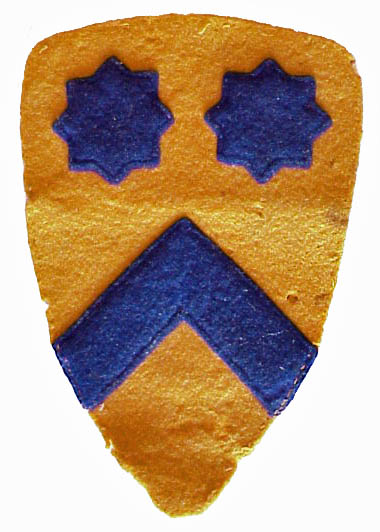
| 
|
| 36th Division First World War | 81st Division First World War |
| embroidered on wool | felt on felt |
Shoulder sleeve insignia of prior to the Second World War were often manufactured of felt on felt. Many of these are very crudely made in the field. Others were embroidered or machine woven. This site does not concern pre-World War Two patches, so I will not detail the various different W.W. I or pre-W.W. II styles except to say that it is difficult to mistake these for W.W. II patches.

| 
| 
|
1st Division felt on khaki | 26th Division machine embroidered on olive drab wool | 2nd Cavalry Division Felt on Felt |
It can be difficult to distinguish World War One from Post-World War One shoulder sleeve insignia. A clue is often that the postwar ones are more regular in their appearance. World War One patches often appear crude and oversized when compared to more modern ones. Many World War One units were not active during the postwar period and should not have postwar variations. One interesting type of patch attaching system used in the postwar period was the NO-SO. These were patches stretched over a metal frame and attached to a metal plate on the inside of the uniform.

The most common W.W. II shoulder sleeve insignia was machine embroidered over a base material, which was totally covered with thread. These proved to be extremely durable insignia. This basic manufacture style continued into the post-war period. Based on manufacture alone it is not possible to differentiate World War Two patches from those made in the immediate post-war period.

One favored variation of machine embroidered patches among collectors are those whose reverse show olive green colored bobbin thread. These appear to have been made only during Word War Two.

| 
|
| 36th Division | 36th Division |
| with olive drab border | with non-olive drab border |
Some patches of the early W.W. II period had olive drab borders. These were throw back to the earlier embroidered on wool that showed a border.

| 
|
| Army Air Forces | Army Air Forces |
| embroidered on blue wool front | embroidered on blue wool back |

| 
| 
|
| 36th Division | 36th Division | 36th Division |
| Embroidered on olive drab wool | Embroidered on olive drab twill | Embroidered on khaki twill |
Some period shoulder sleeve insignia are machine embroidered on wool, khaki or olive drab twill. These may be a transitional style used in the 1930s or early 1940s or the work of certain manufacturers. Some of them were worn during the war as witnessed by examples off of veterans uniforms; however, large numbers of unused patches made in this style were sold to collectors during the post-war period. The back of the Army Air Forces patch has a white backing of interfacing, which on used patches is often trimmed back from the border. The above Army Air Forces patch was removed from a "mothed out" uniform.

| 
| 
| 
|
| English made 8th Air Force | Australian made 5th Air Force | Indian made 10th Air Force | Italian made 88th Division (Courtesy Chris Slaff) |
Some collectors criticize the term "theater-made" but it is generally understood to indicate a patch made outside of the continental United States often in limited numbers. The English made 8th has shorter wings than the typical U.S. machine embroidered variety. For a more complete discussion of foreign manufactured U.S. Military Patches see this page.

| 
| 
| 
|
| Bullion Army Air Forces | Italian made Bullion 5th Army | General HQ Southeast Pacific | Ledo Road |
Wearing fancy bullion embroidered insignia was not high on the combat soldier's list of priorities but numerous examples of bullion embroidered insignia exist from the war or the early post-war period. The most common patch to on found in bullion is the Army Air Forces insignia. Insignia of units serving in Italy, such as the Fifth Army, are well represented. The General Headquarters Southeast Pacific patch is a much more attractive piece than the typical U.S. machine embroidered issue. It is assumed that bullion shoulder sleeve insignia were theater-made for the most part. Many of these date from the occupation period and are technically post-World War Two era insignia.